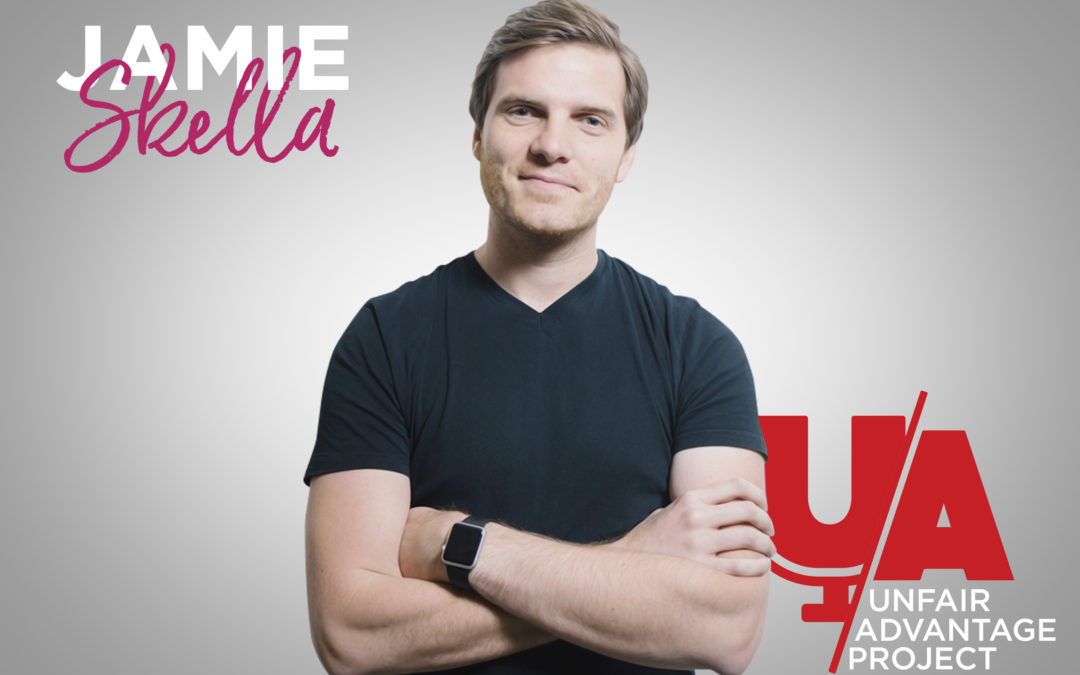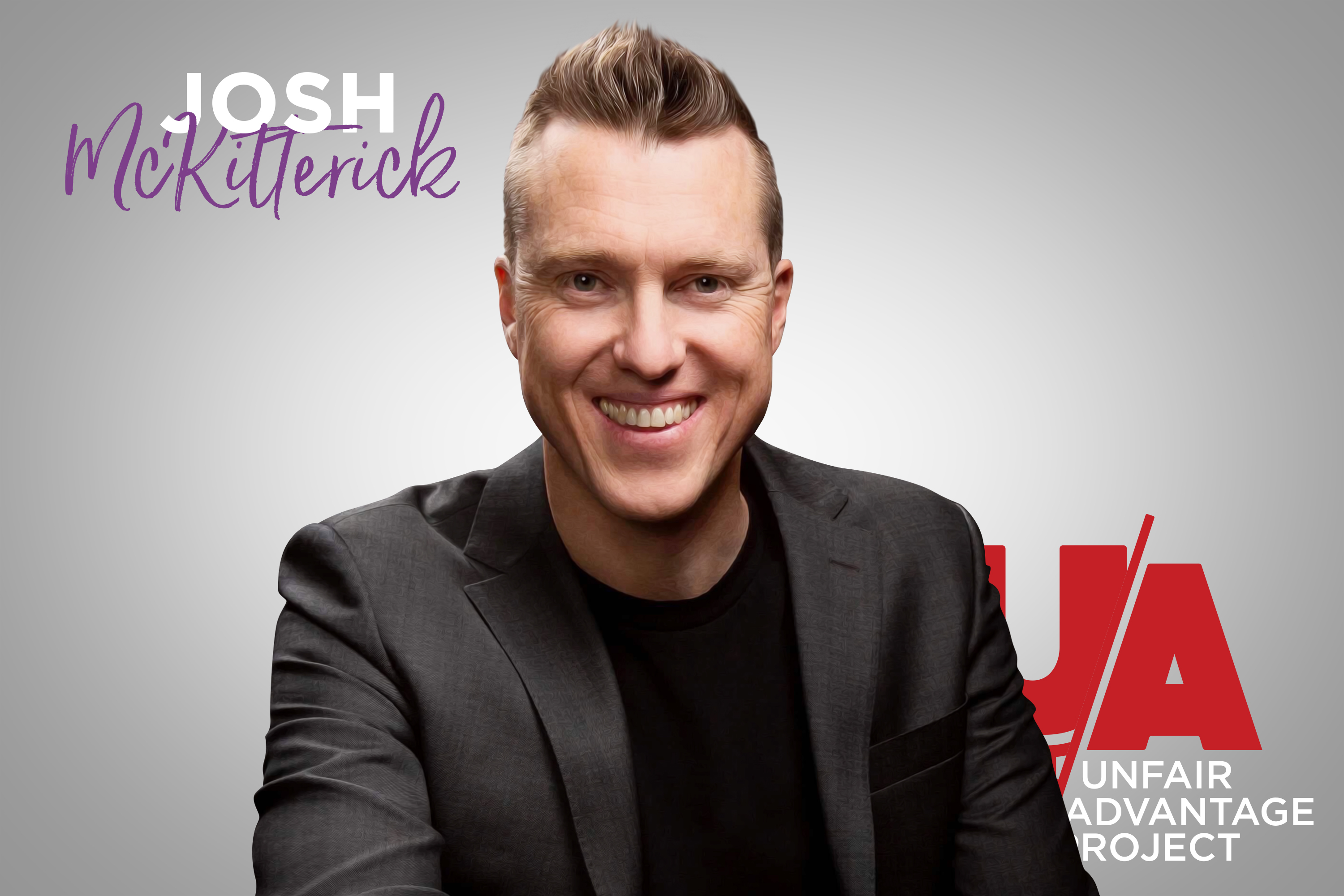Podcast: Play in new window | Download
Subscribe: Apple Podcasts | Google Podcasts | RSS
Show Notes:
Introducing Jamie Skella – the mind behind the world’s first blockchain voting system [00:49]
Why is Jamie considered a genius? [01:34]
What is blockchain? [03:31]
Relationship between double spend problem and blockchain explained. [04:01]
Goodbye microtransactions, welcome nano transactions. [05:44]
Jamie talks about the might of blockchain when used for a voting system. [07:50]
The influence of blockchain to supply-chain. [08:49]
How does blockchain promote accountability? [10:40]
How important is user experience for people using blockchain-based technologies? [12:07]
What is cryptocurrency? [13:51]
Is it wise to move entirely to cryptocurrency? [18:50]
The volatility of cryptocurrency explained. [19:31]
Jamie reveals some more benefits of the blockchain technology. [25:16]
Is user experience affected by behavioral psychology? [26:02]
What is user-centric thinking? [29:37]
What makes design intuitive? [31:35]
How can cryptocurrency help people in times of financial crisis? [33:22]
Jamie rejects the idea that cryptocurrency was initially invented by black market. [39:24]
What advice can Jamie give to people interested in cryptocurrency? [41:42]
Jamie shares some tips on identifying reputable cryptocurrency platforms. [43:29]
Follow Jamie Skella:
LinkedIn – https://bit.ly/2RxicAW
Twitter – https://bit.ly/2PkIlBL
Narrator: Welcome to the Unfair Advantage Project – unique perspectives, practical insights, and unexpected discoveries directly focused on giving you the unfair advantage. Introducing your hosts Nadia Hughes and Terence Toh.
Terence: Welcome to the Unfair Advantage Project. I am Terence Toh managing director and founder of Strategiq Corporation. I’ll be one of your hosts today joined by Nadia. Good morning Nadia.
Nadia: Good morning Terence! I’m Nadia Hughes from Smart Business Solutions and I’m very happy to be here today.
Terence: Great. And today, we’re really excited to be joined by Jamie Skella. He’s the co-founder of Horizon State and also devised the world’s first blockchain voting system. And today we’re going to have a little bit of a discussion about Blockchain, crypto currencies and some of that stuff. So welcome Jamie.
Jamie: Oh well, thanks for having me.
Nadia: You are very welcome. And the reason why you are here it’s your presentation on the Xerocon. And I was recently going to that conference where all accountants hang out. And it’s apparently known now, schoolies for accountants. There’s was a big bash. So, when your presentation come, I actually was thinking well it’s a time when I can check my emails and the few things. I’m sorry that’s the truth of it. And suddenly over my ears freaked and I’m just going oh wow, this guy knows his stuff. So, I kind of treated you straight away like a genius. The reason why I treated you as a genius is because you explained a very complicated concept in a very simple terms and I could see relief on the faces of other accountants as well as… I could not see my own face but pretty sure it was relieved as well. Explaining this what we struggling to explain to our clients in simple words. It’s Blockchain. What is that about? Because we have to explain them, also the effects of it when they trade out there. How they have to treat it for tax purposes, and how, where they have to recognise revenue or it’s an asset so it is a lot of things going in accounting world. But I won’t bore you with it. What I do want to ask you it’s about unblock the blockchain.
Jamie: It was great a conference and pretty spectacular production. I think it’s one of the biggest ones that I’ve spoken at. There was about 3,500 people in the audience and I think there was this big centre radio stage with seats all around. So, it was a bit of a rock star moment which was just bizarre considering that I was talking to a room full of accountants.
Nadia: Hey, they are cool.
Jamie: So, yeah. Look at… I mean the premise of the talk in terms of unblocking the blockchain, and I didn’t choose the name for the talk by the way. But but that’s in effect what the context of the content was. And so, it was really talking about at a higher level. This new asset class starting with bitcoin and talking about what it represents philosophically but also how it works technologically. And then the implications for this technology across various industries. And a quick explanation as well of I think how to explain it simply as you say it. It’s early days for the technology. It’s overwhelming for a lot of people. I mean it’s really really deep subject and I’ve been trying to explain it simply for the last 18 months since I tipped my toe into this space professionally. So, the reception was great. It went really well. I think there was a really huge amount of positive feedback.
Nadia: Great. So, can you just explain for our listeners in the very simple terms what is blockchain?
Jamie: Yeah. Well, I mean look in. I’ll try and run through the presentation. It’s cool, in a two or three minute of block and we’ll see how we go. But basically it all sort of started in terms of the world’s first publicly used, understood, propagated blockchain – it was Bitcoin with a capital B. So, we typically uppercase the B for the network and we lower case b for the currency because these are two separate things. The network itself is a blockchain, the Bitcoin blockchain. Then we have its native asset on top of that which is bitcoin – a lowercase b. And this is a big deal because it solves the Byzantine General’s problem aka the double spend problem. And this is obviously something that probably resonated with the county audience. Because what it means is that finally we’re able to create a digital assets with true ownership and rest assured that when it’s transferred, it really is transferred. That fraction of a bitcoin has gone from me to you Nadia and that now you are the actual owner of that little slice of a bitcoin. Now this sounds completely intuitive to most people but these days it sounds like it should be possible of course. But the reality is up until recently 2009 it just wasn’t. If we imagine for a moment that an MP3, a music file was legal tender, that the federal government said we could spend that in stores then the reality is that merchants wouldn’t really know whose copy of Alanis Morrisette – Jagged Little Pill is authentic and which isn’t. Because of course I can copy that a million times and I can send it via your email while maintaining a copy or send it via email while maintaining a copy and so bitcoin changes that. Bitcoin’s blockchain changes that. So, that’s in a nutshell the technology but of course the implications for this a pretty far reaching in terms of economic benefit. And we have this new asset being used not only as a medium of exchange but as a stored value and a unit of account. It means that international remittances are spectacularly low which means that Africa can start to be brought into the modern economy instead of being taken for a ride. There are benefits to the technology from a technical perspective which have economic implications as well such as for example 18 decimal places. So, forget about microtransactions and start thinking about nano transactions. We can start trading jewels instead of kilowatt hours. Some really incredible stuff can start to happen when you have a unit which can be divided down so far and transmitted virtually instantly, settles virtually instantly and done so incredibly cheaply. And so some of the real world examples I gave for this conference to help people open their minds to the possibilities. One is a sort of a brand new Spotify competitor where instead of having a middle man such as Spotify taking 12 or 13 dollars and the cents go to artists, we have a much more direct relationship where a foundation maintains the interface and instead they’re getting the fractions of that subscription and the rest is more of a direct relationship between us and the artists that have such a great impact on our lives. We can think about peer to peer energy trade over in Perth, Power Ledgers doing some great stuff on micro grids where Joe and Sue can automatically autonomously trade energy between one another rather than needing to buy energy from the big boys such as Origin or Energy Australia who have again massive overheads. Only about 20 or 30 percent of your power is actually power and so if you can strip out most of those overheads and create local economies, the opportunity for people to trade energy autonomously, reliably and in a trustworthy fashion using this technology then that’s a huge sort of paradigm shift in our economic behavior and the way that society organizes itself. But in the final example is this sort of stuff i’ve been working on which is a little bit more abstract. But it’s about retrofitting a blockchain transaction to instead of be financial, purely financial in nature, that transaction represents something else such as a vote. And the reason this is possible and the reason this is really quite profound is that not only does this technology enable, for example, 18 decimal places and its settlements and low fees, that these transactions are also immutable, and irreversible and they’re post unforgeable. They are perfectly accountable. They are perfectly transparent. As you can imagine, these are also all terrific properties for a vote or a voting system. It effectively means that we can create a vote using this technology – a digital vote which is tamper-proof. It’s unhackable. It can’t be changed after the fact which means using this technology we can work to an eradication of corruption.
Nadia: You’re telling me that Trump would never be elected.
Jamie: Well look, we can’t change election results. But using this technology what we can do is to…
Nadia: Well, Russians are blamed for tampering. So, I’m just wondering.
Jamie: So, I think it was probably more to do with social engineering than actual ballot tampering. But there are certainly examples of ballot tampering outright, explicit ballot tampering in many places around the world mostly developing nations where this technology would rule that kind of behavior out. So, it adds a massive layer of legitimacy to that kind of practice. And look I think probably a couple other really nice examples. Again they’re more abstract ones. They’re less Economy and Finance. And these are such good examples. But blockchains are also seeing greater adoption in supply-chain right now which effectively means being able to log something at the point of departure or point of manufacture and have it immutably traceable and logged throughout the entire supply-chain to the point of delivery or destination. And this means that the recipient has perfect proof of its origins without any question that somebody has tried to change or tamper with that to, for example, deliver fake pharmaceuticals and kill people. Or deliver fake diamonds, blood diamonds or conflict diamonds. And so, all of a sudden we can start thinking about how to improve humanitarian practices and improving the quality of, for example, those involved in the mining of diamonds. Fingerprinting it inside a mine with 40 clear metrics with the effectively unique and then being able to log back to a blockchain and ship it off and have the end user know that this diamond came from this mine and be able to then go off and research the practices and track record of those involved in the mining. And then also things like food stamps. Jordanian refugee camps where Syrian refugees are biometrically fingerprinted at the point of entry using retina scans and then they have food stamps, food tickets assigned to their identity. This means that the food stamps can’t be forged. They can’t be counterfeit and most importantly they can’t be stolen. So, there’s a reduction in violence and it means that whenever they walk into a store within the camp, they are retina rescanned then it’s deducted from their balance using blockchain technology. That particular pilot was using theory of public blockchain back in last October I believe. So, lots and lots of great stuff. It’s an emerging technology but it’s being used for lots of tremendous stuff right now as well.
Nadia: And the government’s obviously expressing a big interest in developing these technologies because they effectively introduce this level of transparency. But it’s also introducing a level of accountability…
Jamie: Exactly.
Nadia: which possibly can be not such a good idea for a lot of people who is now benefiting from tampering or some sidekicks from not being so accountable. It’s being a woman I just like thinking oh that’s it. End of there Prada bags. And that’s…
Terence: You made…
Nadia: Yes! That’s it. You can’t just pretend that you own a Prada bag anymore.
Jamie: That’s right. I mean they’re both great points. And look I mean if somebody is passing you on the street, you’re at the cafe with a friend, they’re probably not going to ask to see the blockchain, supply chain record for your Prada bag. But it’s absolutely right. I mean retailers they’ll be held accountable and consumers will be able to verify the authenticity of these items. And look yes the accountability in regards to politicians, some of them might not like it so much. We’ve already had interesting conversations and look a full disclosure I no longer work for Horizon State – the company that I devised and the building of this technology with. But tremendous ride and they’re having incredible conversations all around the world. But yes there is resistance from some politicians in some regions while others are very excited and wanting to embrace it wholeheartedly.
Nadia: And how far do you think this technologies being fully embraced and taking basically widespread in our lives?
Jamie: We’re a ways off. As we had a quick chat about offline, a big issue with this stuff right now is really the quality of user experience to use blockchain-based tech. Now the voting tech we developed was designed to be very much a Web2.0 experience. So, despite the fact that there was very clever things going on behind the scenes really the experience for users was just a modern experience which we think is really important. Because too often a lot of this tech is very unintuitive, it’s very complex. Reminds me of being an end user in the early 90s messing around with the internet and PBS and later the web. And while as a curious teenager, it wasn’t too hard to get my head around. That unfortunately just was more or less impossible for anybody who didn’t fit that sort of personality definition. So, we need experiences to get a lot better for mass adoption. Right now I sort of feel like we’ve reached saturation in terms of the people already using blockchain technologies for chain products and services, cryptocurrency. I feel like we’re pretty saturated because it really is a struggle for most people to figure out how to get involved how to use it.
Nadia: To begin with, Jaime, it’s a struggle for a lot of people to understand what it means. And again utilizing the example, it’s probably the husband’s sitting there reading cryptocurrency and his wife is wondering where all the money goes. And then suddenly all bank balance is empty and the house has to be a for sale. So she… That’s a game but it reveal example but it’s related to real case. Then wonder is what the hell is cryptocurrency? How does it work? And how we end up selling our house? Can you explain in the very lame terms what cryptocurrency is for this suffering wife?
Jamie: Ultimately. Well, philosophically at least, cryptocurrency represents a way to separate money and state. We talk about the concept of separating church and state. Many people would argue that separating money and state also isn’t such a bad idea. Others believe that it would probably be Armageddon. But that’s effectively what it sets out to achieve is to maintain some independence and some self-sovereign assets, financial ownership over around that wealth and over around trade. And so this… the way this works is effectively by creating a technology that can remove middlemen from these exchanges. So, banks is really what I’m talking about primarily. The ability for you and I to exchange something of value, of digital assets and do so without it needing to go through a middleman who more or less serves as an IOU, an identity verifier. So, they say look Jamie is good for it. Nadia here’s the cash. In actual fact that settlement doesn’t take place for hours, days sometimes weeks as the system of IOUs and guarantees along the way. And this technology more or less replaces that IOU and guarantee system. It makes it possible for me to send you something digital. And you receive it unasked. Rest assured that that transaction can be trusted. Now the example I gave at Xerocon about how that’s possible is a point worthwhile making here too which is that if you want to talk about this in terms of an analogy which might be easy to understand. Let’s pretend for a moment that you and I have decided that we want to exchange five dollars worth of value. It doesn’t have to be five Australian Dollars but it’s five dollars worth of value and we don’t want to use an intermediary – a bank. So ,we gather up 200 of our closest friends and associates and we get them to come over to our place with a record book and a pen. So, everybody is there and they see this transaction. They witnessed this transaction take place. They record all the details about it. So, the location, who it was from, who it was to, the timestamp, they verify that the signatures were correct all these sorts of details. And this is a shared reality. Everybody has seen the same thing and recorded the same details. And in blockchain terms, what we have reached it was consensus amongst the network. And so, they all go back home. Some of them live around the corner. Some of them live across the road and around the street, the next suburb, interstate, overseas. Now you as a bad actor if you wanted to go in and try and changed this record five dollars of value to be fifty dollars of value. You really sort of just need to add an extra zero. But because this database, this record book, is novel in nature, it’s underpinned by some interesting combination of distributed system and cryptographic ideas as well as some concept such as proof work. You would conceptually at least and this is technically an imperfect example but it’s a good entry point. Conceptually you would need to break into every single one of those persons homes and change that light items simultaneously without waking any of them up. And so, in practical terms this is currently an impossible feat. But with my computer scientist hat on, it is still highly improbable. So, that’s fundamentally how the technology works. And there are lots of great knock on effects because of how it works for society and people’s health and well-being. In fact if we think about the advantage of not using a bank in Australia, well that is probably pretty minimal because we live in a relatively stable economy with a relatively stable democracy. We’re doing okay. However if you’re in Africa or if you’re in Cyprus, if you’re in Argentina, then the opportunity to protect your own net worth, to protect your assets, to distance yourself from the nation state when it comes to trade and commerce, this can be a huge leg up. Because historically what we’ve seen over and over again is that currencies reach a point of hyper inflation and then they reach hyper deflation in terms of value. We see banks freezing funds based on orders from governments. We see banks taking money from customers, a clip of the ticket or entire amounts. We see people’s finances being frozen unlawfully. And these happens in moments of crisis. So, cryptocurrency is it’s almost a bet against the state and it really is about taking control back of your own assets.
Nadia: I wish we had this technology back then in 90s when I was in Russia. And suddenly all our savings overnight turned into nothing it’s turned into dust. Life savings of my grandma. She just basically gave it to me on my wedding and she, in very sad sort of way because back then it was worth something and suddenly overnight when came in the 90s it was worthless. So, it was a lot of sadness. It’s meant a lot to me because it was your life savings. But in monetary sense, it was worthless.
Jamie: It’s not an uncommon story throughout the last sort of 70, 80 years. We’ve seen this happen countless times in many places which is really unfortunate. And now look I’m not advocating that everybody move entirely to cryptocurrency. I don’t think that’s wise. But I think it would also be unwise to not have some cryptocurrency wherever you live. Because even in Australia, these things are cyclical. We aren’t going to have a strong, stable economy forever. So, outside of a speculative investment it is also good for people to get their head around this technology, get their head around the value of the asset class, why it’s important. Because this is the future. It’s here to stay. And while we will still be dealing in our local currencies for a long time to come and the banks are disappearing overnight, this is going to play an increasing, at ever increasing important part in our lives.
Nadia: And what do you think is the major dangers suddenly when people go all on cryptocurrency?
Jamie: Well, it’s just the volatility. I mean we are seeing some really great work being done to introduce what are called stable coins which maintain the same major benefits of cryptocurrency which is that it’s immutable when it’s censorship resistant and the banks can’t take it, the government can’t take it and it has 18 decimal places or less or more depending on the architecture for narrow transactions. And it settles instantly and it can be sent across borders in moments. All these sorts of incredible things. But it maintains a stable price which is really important. Because right now, even the most stable cryptocurrencies which is probably Bitcoin because it’s the most mature with the largest market cap and the largest number of network participants. It’s still highly volatile. I mean that still has 25 percent swings some days and then over the course of ten months, as we’ve seen, it can lose 80 percent of its value. So, the big risk here is that by going all in on cryptocurrency that you prove, you potentially reduce your net worth by 80% which nobody really wants. I mean that’s life for some people. Think. For me personally having a relatively large risk appetite, I think me having 15 or even 20 percent of my net worth in crypto makes sense for me. A lot of people I don’t necessarily think that it’s wise to play with them or more than a few percent of your net worth. Certainly if that savings is meant to be going towards things such as a house deposit especially given the housing market in Australia right now, that’s probably not wise given the volatility of crypto.
Terence: So, I guess it’s kind of changed the way I was thinking of crypto as just the decentralized currency. And I was really… And blockchain just thinking about it as being currency. I’ve got to change that now based on this conversation to decentralising the control of transactions. Is that kind of am I on the right track?
Jamie: It’s so much bigger than finance currency, economics. I mean obviously the killer app, the first killer app and the most obvious application for this technology is indeed economic in nature. It’s about digital assets, being able to transfer them as a medium of exchange in forms of payment to a store of value. That’s pretty profound unto itself especially if you think about the fact that right now cash in Australia is dying. I mean already about 70 percent of transactions that take place in this country are digital. But what that means is that 70 percent of transactions are going through banks and intermediaries which ultimately means that those transactions are available. Now that’s not to say some strange authoritarian rule is going to come into play and these are going to be outwardly exploited. But the bottom line is we are sort of heading towards an Orwellian future here where the flow of money is completely overseen and controlled by large intermediary institutions and governments. And so, the financial benefit here in crypto currency is that we sort of have created a digital cash where you and I can trade peer to peer outside that reality which I think is an important point to make. So, finance is big but that’s not everything. If we think about the examples I gave before for voting or supply chain or humanitarian aid, these transactions, because of I guess the technical details about what they could achieve, makes it a much bigger and broader proposition than finance. And yes, it has the opportunity to remove middlemen in many ways, shapes and forms. The Spotify example I gave really, in the future. Give it 5, 10 years maybe more. There’ll be the opportunity to unseat some of these large capitalist for profit institutions that sit in the middle of us and artists. The Power Ledger example. The ability to remove large capital accruing institutions making crazy profits, we’ll be able to move them out of the way of that relationship we have with energy sort of creators, miners, suppliers. Throwing some solar panels up on the roof means that you are effectively now own now one piece of Origin Energy for your local neighborhood without the need for those big intermediary organizations. So, these realities are still a fair way off. Of course this isn’t going to be an overnight change. But this change is now possible and it is happening already.
Nadia: Because they will attract the huge balancing of wealth, it’s going to be a lot of opposition to those transactions of course as you can see. The moment we are decentralizing this thing, it’s just means that only if you selected individuals going to lose a lot of powers. Unfortunately these very few selected individuals are accumulated the most of wealths and money talks as you know. Therefore, this is one of the biggest probably predicament in making this available. Second thing, you said that’s going to be user experience and this one I would like you to unpack from the point of view of any business owner experience. Because we all offer out there something we think of value. We think ourselves as great specialists. We think of ourselves that we created some product which the world needs. And you can see that cryptocurrency is exactly this product, the world needs it. But you said that because of poor user experience, because of the users are not educated about it as well, so we have an issue of understanding the market is not a really savvy what it represents and how they can use it. It’s very common to any business owner. This problem, user experience. That’s what I’m asking you to unpack a bit more.
Jamie: Firstly, you’ve made a point just earlier which was about sort of equalization of I guess wealth accrual which is philosophically a really important point to make. It’s probably something that really underpins a lot of the original movement which is that. Well, there will always be inequality. For example there will be people that have way more bitcoin than other people. It’s about shifting this power and capital vacuums away from centralized institutions. And what this technology enables, by removing those intermediaries or diminishing the role of intermediaries, is a much more equitable flow of capital throughout our economy. So, it’s more evenly dispersed amongst the people rather than it all of a sudden starting to build up and a mass with large businesses basically. So, it’s a nice thing to think about. On the topic of user experience, yeah. I mean I spent 20 years in Ux design kind of… I mean I started out as a web designer – building and developing web sites as a 13 14 year old and going on to start my first business out of that. And it became very obvious, very fast that some of what I was doing was really effective. And that’s what led me down a path of diving into a behavioral psychology and starting to think more deeply about why my interfaces are received well or why it’s effective for the business and why it isn’t. And so I’ve gone on to work as the user experienced director for Tatts Group, just Tattersalls lotteries in Victoria, as well as head of UX at the AFL. I really have felt ever since I dived into technology as a tween that design sort of underpinned a way of thinking which was going to have an effect on everything I did, had far broader effects than what most people recognize. To be a designer is ultimately to be a problem solver. So, you can be a fashion designer or you can be a web designer. But this designer mindset is really important and it’s really important if you want to be successful in whatever it is you’re doing. And I really believe that my time working through these problems and thinking about how humans use technology, have I resonate that the design of that technology both from how it works and how it looks perspective has been a really significant part of the success I’ve seen already working with blockchain technology. And it’s something we need to see a lot more blockchain startup embrace I think with a lot more vigor because it seems to be ignored a lot at the moment.
Nadia: Yes. And… What your ultimate advice would be for business owners out there? Because they are having great ideas. They are having great products. But how would they improve user experience?
Jamie: Well, it’s important to say that user experience is silver bullet. It’s important. It’s really important. But ultimately I mean user experience conceptually is kind of everyone’s trip. I mean if that kind of thinking and that kind of design culture doesn’t permeate through the entire operation, customer support, marketing, obviously decision makers and the executive, then a design team unto themselves is going to be pretty ineffective. So, it’s really I guess trying to think holistically about your company and about the experience that your customers have trying to make sure that the entire organization is receptive and understanding to the importance of this way of thinking. And it’s easily demonstrative as well. All you have to do is look at some, long as you know, investment strategies that have been undertaken with various funds focusing specifically on organizations that value design, and user experience, and customer experience. Above most others people that, organizations that seat designers at the big table that really think about it strategically, they place a lot of value on it that makes sure that design leadership is as important as economic leadership and commercial leadership. These kinds of organizations are Nike, the Apple of course. And what you see that when you invest in these kinds of companies, this definition of what makes a good company. Understanding where their focus is lying and seeing that one of them is absolutely on design, they outperform the portfolio of these companies, they outperform the rest of the market way in excessive 200 percent. And we see this all around the world. We see it in London and we see it in the United States as well.
Terence: Just a simple… To me I think about it. I’ve done a lot of modelling for my business and actually helps other people to some work on their businesses. Obviously my role anyway. And is it just as simple as placing the user at the center of what you’re doing? Instead of trying to design this product and hope that you can get someone to buy it, I put the user in center of it first.
Jamie: It is. So, you might have heard of the term user-centric thinking or user-centric design which is really about making sure that we try to remain objective. Once upon a time I may be designing interfaces with an aesthetic that I liked and colors that I like it. Of course that’s an incredibly terrible way to go about it. This is becoming more and more commonly understood that even as the designer, to be a great designer and to be really proud of your work, it sometimes is designing things that you don’t necessarily like personally but that’s okay because any good business will be able to identify a specific target market, a demographic of customers or end users that they need to be successful. So, for example if we’re designing technology for the elderly, then a flat UI aesthetic might be so good for them because it’s just not as clear. I mean literally it’s not as clear, it’s not as effective than skeuomorphic which is making elements look like they’re something out of the real world. Even if audience, this still remains the case a lot of the time although digital natives, they were able to take on flat UI much more intuitively than the old ones. But these are the sorts of the considerations that need to be undertaken. And that’s obviously just one example in relation to digital UI. But that really permeates through the entire decision making process for any kind of product design or business design. It’s about, you know, industrial design in terms of engineering and ergonomics for devices that are held. In terms of the business and its market position and marketing. Again, there are best practices. But best practices won’t always apply to what you’re doing. If you have a very specific niche that you need to target and it’s about understanding that user base, that niche base that you are going to require to be successful.
Terence: You mentioned earlier that you think we’ve reached saturation at this point with digital currency. But I think that also the UX has a lot to do with that. Right?
Jamie: We have for the moment primarily because of user experience and that it’s too hard, too complex, it’s too unintuitive. I mean the definition of intuitive in practical terms really comes down to the fact that it’s something that at least in some way is familiar. That’s what makes something intuitive. It’s like well this is very quick for me to understand or use or learn. And the reason for this is that there’s been something previously in our lives which has shared some resemblance or some relationship. So, it seems intuitive but really it’s because it borrows on certain interaction patterns or certain ideas or certain ways of working which we’ve done before in some way, shape or form. Cryptocurrency really isn’t that for most people. It’s completely foreign. And so, we need to get those experiences a lot better before we see truly mass adoption of the technology. Because right now it’s yeah, it’s for the curious. It’s for the risk takers. It’s for people that are tech savvy. We do see lots of other people of course getting into it as well. But we’ve got a ways to go. I don’t think until the experience is as good if not better than the ones that people are currently having with their banks or with Spotify as examples, will people use this new kind of currency or will people use this next generation Spotify. They just won’t do it if it’s harder to use. That’s the first hurdle.
Terence: Okay. And so, just going back to that… to the cryptocurrency side of things I guess back away from the UX a little bit. You mentioned before, we’re talking about crisis. We’ve had the GFCs. It is still very recent memory. I guess lots of factors that came into something like that and we were only in a matter of years I guess from another crisis of some sort. What role is cryptocurrency going to help us to prevent a crisis or make it different in any way?
Jamie: Well, the idea I think is that it’s going to help people protect themselves from those sorts of events. So, it’s the safeguard part of their net wealth from those kinds of events. The idea here is that in a time of economic downturn or turmoil, that the value of the assets will in fact rise or at least become more valuable against those local economic units such as the Australian dollar. So, if we think about… Well, there is a slight chance that Australia might be in for a bit of a bumpy road over the next two or three years. There are right now rumors circulating about policies that a shortened government might impose if they get to power, which they might because that Liberal government is currently just completely in shambles, things surrounding negative gearing and interest rates. In a worst case doomsday scenario, as reported on the news in a very frightening fashion, is that this could mean the housing market collapses by up to 40 percent. I think that’s unrealistic but let’s call it 15 or 20 which might still be unrealistic. But for the housing market to drop by those significant percentages also means that the country probably falls into a pretty deep recession. Not as bad as what we saw with the US but it would be pretty bad. And then all of a sudden that affects everything. It affects jobs. It affects the value of our money versus other money around the world. And it affects the price of goods and services in this country against a compromised dollar. And so, by having Bitcoin or the theory or some portfolio of crypto assets, it means that you have something which is decoupled from that crushed economy, from that recession. So, it’s not going to make any country recession-proof. Not yet. But it will certainly put people in a position to maintain control of a greater portion of their assets. At that point in time more volatile than the current crypto markets. So, I guess again it’s about balance. It’s about rational consideration. It’s about thinking carefully about how much you put at risk into these new, experimental, cutting edge technologies and currencies. But absolutely if it’s an offset, it’s really some protection against those kinds of situations and they will happen. Absolutely.
Nadia: And we have to… You’re quite right. We have to be very careful. We are not giving here advice to invest into cryptocurrency by any means. We’re just here to explain what cryptocurrency stands for. But also prevent those horrific examples occurring again and again when people actually sold their homes and there’s just cryptocurrency and experience a huge loss. And basically this something which made the lot of financial planners get into their heads because they couldn’t stop this hysteria of people buying these bitcoin when it was hiking. So, that is basically I want to mention.
Terence: Cool. Next question for me is really about the future. I mean what are the future implications do you think of these new technologies and their decentralization that we see?
Jamie: As a whole whole raft of emerging technologies which are going to have compounding effects in regards to how individuals interact with governments and what government’s role is in our day-to-day lives economic or otherwise. And I’ll give you a couple examples. One is obviously cryptocurrency in the sense that while you as an individual were still completely obligated to be transparent and pay your taxes according to local law, it does in reality provide opportunities for people to abstract themselves from local economies. There are people already experimenting by being entirely in crypto both in the United States and in Australia. And more or less divorcing themselves from that country’s regulation, from attacks. And so while they’ll remain residents, they might not be citizens for taxation purposes and it’s that they’ll be in a tax haven more or less living off of a cryptocurrency and converting that in and out using various services to spend day-to-day in supermarkets and online. So, interesting things there for the government to think about. Partly I guess in respect to… Not necessarily how do we prevent it but I guess coming to terms with this reality and thinking how they best manage it because it’s not going to be something that they can stop. If people want to do this of course laws can be imposed and regulations can be applied. But you’re talking about technology which kind of can’t be shut down and can’t really be restricted unless you want to create a national firewall like China which really doesn’t deter anybody that’s truly motivated to do these kinds of things anyway. Another example is autonomous vehicles. Again implications for government is that if you have vehicles that never speed, and that never drink drive, and that never run red lights, then you have a reduction in opportunity for revenue generation through those kinds of fines. And so the sort of picture that I’m trying to paint here is that within the next 30 years based on a combination of technologies, autonomous vehicles and other crypto currency, we’re going to see the government. Maybe not become… I don’t think we’re going to get to a point where we do separate money from state especially not within that window of time. But where the relationship between money and state will change pretty significantly during that time and the wealth for government will change pretty significantly during that time. And so, look it’s really hard to predict the future. As a futurist I suppose I try not to think about absolutes because that’s generally just hyperbole and instead think about the potential futures the three or four or five places that we might end up. And there are certainly some pretty dystopian outlooks and there are some pretty utopian outlooks but the bottom line is that things will continue to change. They always do. They always have and they always will. So, for me it’s always thinking about instead of seeing change as a threat, instead of seeing change as something scary, I always try and appreciate that everything will always continue to change and try and capitalize on that. Sea change as opportunity.
Nadia: Is it true Jaime that cryptocurrency was invented by black market initially?
Jamie: Look. It wasn’t invented by the black market. But in typical fashion, criminals always the first to take advantage of any new interesting technology. And when it comes to the commercial…
Nadia: They’re very advanced.
Jamie: Yeah. They are absolutely. Well they have to remain on the cutting edge, they have to try to remain ahead of norms ahead of traditions. And so, when you offer them a technology which can be anonymous or pseudo anonymous, that can enable them to transfer across borders instantly with low fees outside of the control or visibility of banks, this is obviously a very attractive proposition to criminal activity. But the bottom line is that most crime is still conducted with cash. I mean people say that maybe cryptocurrency shouldn’t exist because it’s used for criminal activity. Well cash is used for a lot more criminal activity. We see this for a lot of technologies. Just two trends. One is the adoption for criminal activity and the other is the adoption by the point industry. Once the point industry has adopted some technology then it’s going to be the winner. And so if you think about Beta versus VHS, if you think about CD/DVD Versus Blu Ray, if you think about the early days of the Internet, again the internet was adopted initially for porn and crime and of course is now gone on to shape the world in incredibly positive and profound ways. And we see that with every major technology is that initially it seems a little bit dubious but over time if the technology is worth its wait, then it always turned itself around then we end up seeing its greater use case being positive things rather than things might be perceived as negative.
Nadia: It’s an interesting spin on criminal world that they are actually our pioneers. And we should be forever grateful for that.
Jamie: Yeah. As long as they’re not hurting anybody. I guess….
Nadia: There would be some collateral damage along the way of the progress. So I just… we can’t exclude that. But at the end of the day for greater good. Now they probably justifying it. Interesting and never thought that we will end up there. Saying thank you to the criminal world.
Terence: So Jamie, what would be your advice for someone who listening to this and things? I mean I don’t know much about crypto but this sounds exciting. The future uses for this technology are really exciting and it definitely seems like there’s going to be a big future for it. So, for someone who is new to this, what advice would you give them on?
Jamie: First, if this conversation has interested you I urge you to go and do some Googling for the terms “blockchain for social impact”, “blockchain for good”. These kinds of search terms. You’ll be fascinated to learn about how powerful this technology can be in leveling the playing field, in reducing harm and improving the quality of life for people all around the world. So, blockchain is not the answer to everything but it really is part of the answer for some pretty big problems we have and that’s exciting. In terms of cryptocurrency specifically, you need to play around with it. You simply have to advocating any significant investment. I think it would be completely unwise to risk more than a few percent of your net worth if you wanted to double and actually invest and/or hold any kind of crypto asset. But even just to go on and buy five bucks or ten bucks at 20 bucks worth and get an idea of how it works, I think this is very valuable knowledge. So, jump on to BTC markets or jump onto independent reserve. These are a couple Australian exchanges. You can also check out Coinbase which has a great user experience compared to most other places to purchase cryptocurrency. And yeah, go on there. Have a tinker. Get your head around it. Try your best to get your head around it. Because whether it is something that you use day to day now or not, it probably will be five or ten years from now. So, it’s good knowledge to have. So, don’t be scared about it. It’s daunting at first, it’s get the hell out of me when I first got into it. Even as a technologist working with high tech for a long time now, it was still a big leap to make. There’s a lot to understand but it’s thoroughly rewarding.
Nadia: And how do our listeners know that which platform is credible and which ones they can potentially be scammed?
Jamie: Well, I think any exchange that has been formally recognized by a regulatory body which is many Australian exchanges now. I do believe B2C markets, independent reserve and a new exchange firing up block bid. And I’ve met the founders of a couple of those. They’re reputable institutions. It still without risk. I don’t know what sort of insurances they have against loss ultimately. So, the rule of thumb is always that if you buy cryptocurrency on an exchange, don’t leave it there. It’s not good practice. So, if you buy 50 bucks worth of a theory in Bitcoin, you can set up your own wallet to make it truly self-sovereign which is the purpose of this technology. And so while you’re buying your cryptocurrency from an institution which has a whole bunch of it, cause you might not have any friends you could buy any off directly. Once you’ve purchased that, don’t just leave it on those websites, on those exchanges. You want to create your own wallet which is managed by you, which also introduces an extra and additional kind of risk because the cryptographic keys which provide access to these funds will be totally in your control. That’s what’s scary but it’s also what’s empowering is that you have this private key. If that’s ever lost or stolen then your money’s gone and there’s no repercussion. There’s no 1800 hotlines to call. There’s no… I mean it’s literally self-sovereign ownership. So, you need to think about how you secure your own data and where you store that key. How. So it’s bravely well.
Nadia: Interesting. Anything exciting happening in this… I know it’s saturated, you said already, in sense of what has been invented anything. But something like really truly the most recent exciting developments are out there.
Jamie: The most exciting ideas for blockchain are ones that haven’t even been thought of yet. As I alluded to a much earlier, this is kind of like the Internet of 1992, 1994. We all saw the promise. The idea that you could digitize documents and communicate electronically – sending messages across long distances at low latency and short amounts of time. That was a huge promise. But Uber, and Airbnb, and Facebook the implications and the arrival of those were completely unforeseen. And the knock on effects they’ve had for society are completely unforeseen. In ten or 15 years ago if you were to hop into a stranger’s car that wasn’t a yellow cab, people would think you’re insane. If you were to invite people from around the other side of the world that you’ve never met to stay in a spare room in your house, people would think you’re insane. So, not only with these technologies enabled by time and technology theory and the intersection of things like high speed data networks and the ever increasing power of tiny computers that sit in our pockets and GPS being made something available to consumers with high accuracy. So, timing is off that everything in tech. But it really was those combinations of things that led to cultural and behavioral change. The simplest examples of that but these technologies have far and wide opportunity for change. And I think the best is yet to be seen for blockchain. Like I’m pretty proud of the work I’ve done in electronic voting. The stuff happening in various other industries is impressive. But the opportunities between ten and 15 years from now are going to look very different and nobody, I don’t think, can really imagine them right now.
Nadia: Okay.
Terence: That’s great. We’ve covered a lot so I don’t think I’ve ever taken that many notes in a podcast. Thank you. They are really great conversation and I really like to thank you for everything that you shared with us. I think there’ll be a lot of people listening to this who will get something out of it and really get a much better understanding of what blockchain actually is and how they can, how it applies to them, and maybe their future as well.
Nadia: How can our listeners connect with you? That’s a question we have to ask.
Jamie: So, LinkedIn and Twitter probably best. Twitter I’m just Jamie Skella. One word. And on LinkedIn, just punch Jamie Skella into the search bar. They’re the networks that I’m most active on.
Nadia: Thank you very much.
Terence: Alright Jamie, thanks a lot for being part of Unfair Advantage Project. And I’m sure we’d love to have you on again. Surely you’ve got a whole lot more that you can share with us some stage. Thanks a lot.
Jamie: Thanks for having me.
Nadia: Please reach out if something exciting happening and you want to share with us, we would be happy to hear from you.
Jamie: Absolutely, we’ll do.
Narrator: Thanks for listening to the Unfair Advantage Project. For more curated resources, visit us at unfairadvantageproject.com.
 TERENCE TOH
TERENCE TOH
About Us
The Business Coach.
Terence is the founder and Managing Director of StrategiQ Corporation, a serial entrepreneur and experienced business operator who has founded, bought, grown and sold several … see more

 NADIA HUGHES
NADIA HUGHES
About Us
The Super Nerd.
Are you passionate about the ins and outs out of taxation legislation? With Nadia by your side, you don’t need to be. Accounting and financial planning isn’t just her … see more







